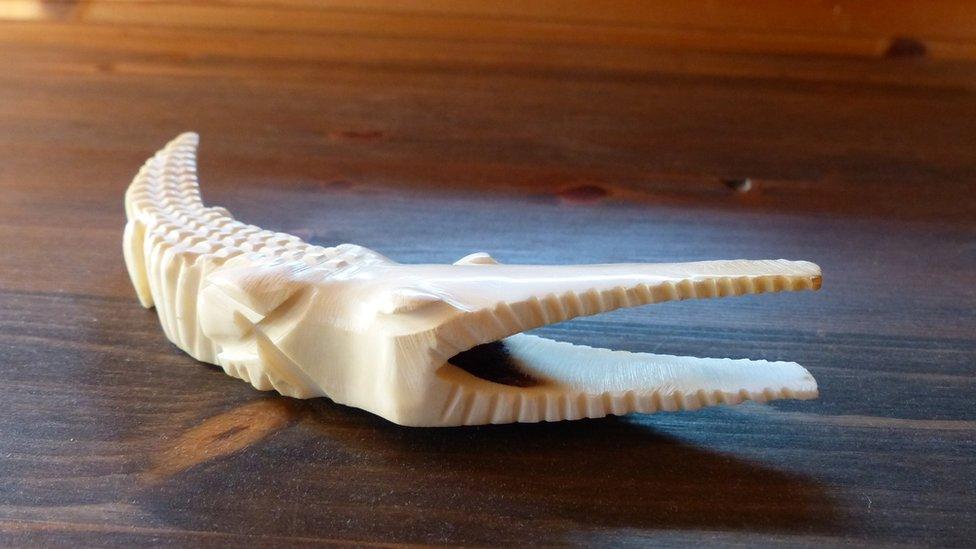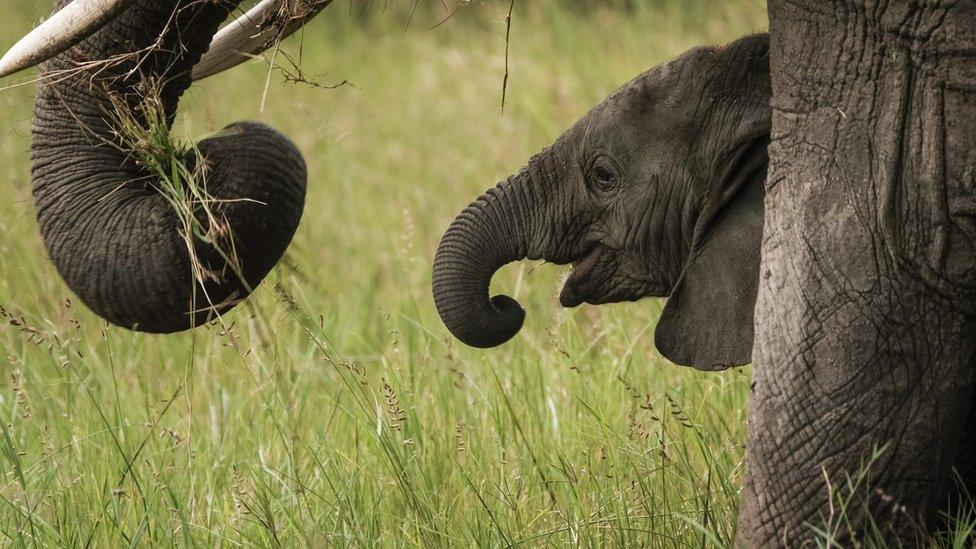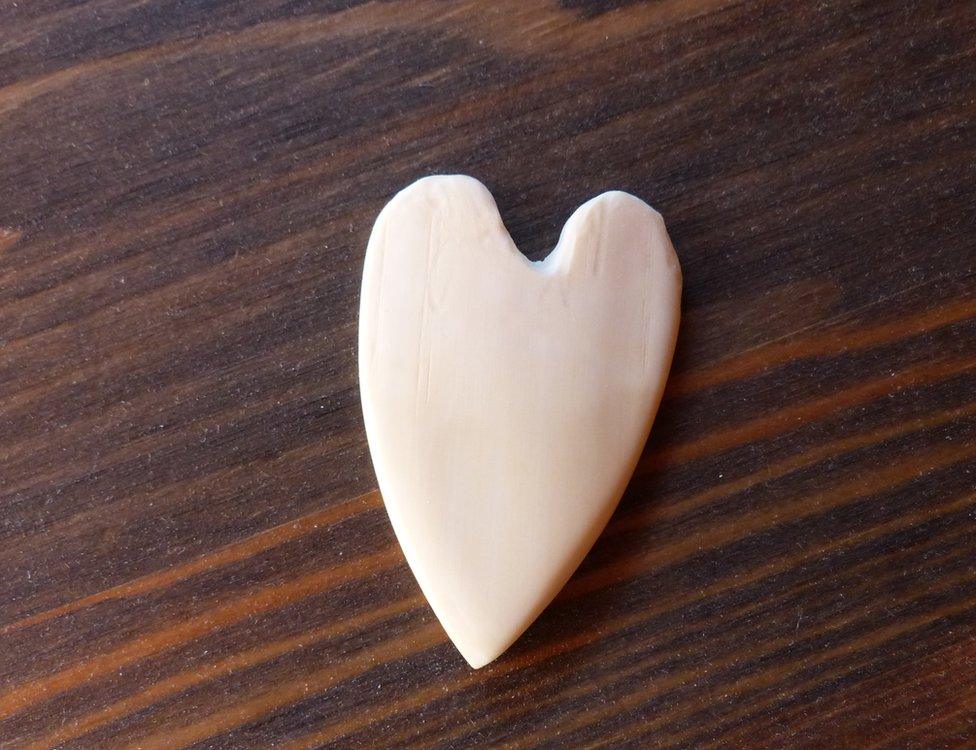Legal EU ivory sales 'condemn elephants'
- Published

The open, legal sale of antique ivory in many European countries is covering up a trade in illegal and recently poached ivory, campaigners say.
Researchers from environmental group Avaaz, external bought 100 ivory items and had them radiocarbon dated at Oxford University.
Three quarters were modern ivory, being sold illegally as fake antiques.
Ivory from an elephant killed by poachers as recently as 2010 was among the items passed off as being antique.
"It's sick," said Bert Wander from Avaaz, which organised the purchase of the items.
"I'm looking at the trinkets we bought on my desk, and to think that an elephant with all the things we are learning about them, about their cognition and their advanced societies, and to think that one of them has died for this bracelet I'm holding now, it makes you sick to your stomach."
The items were purchased from both antique dealers and private sellers in 10 countries across Europe.
All the ivory pieces were advertised as originating from before 1947 or had no date information. The 1947 date is important because the EU classes ivory from before this date as antique and it can be traded without restriction.
When the items were analysed by Oxford University's Radiocarbon Accelerator Unit, more than 74% were found to be from after 1947.
The tests are able to show when the ivory grew on a living elephant, not when the creature died. This means the ivory could have come from elephants killed decades after the date of the sample.

Almost three quarters of the trinkets were illegal under EU rules

The crude nature of many of the items is striking
Of greater concern, though, was the fact that one in five were from elephants killed after the global ban on the ivory trade came into force in 1989. One piece purchased in Spain may have come from an elephant whose ivory was formed after 2010.
All the pieces bought in Bulgaria, Italy and Spain were illegal, as were large majorities of the items in France, the Netherlands and Portugal.
In the UK, one fifth of the pieces purchased by Avaaz were outside the law.
"These shocking results show that the supposed 'legal' ivory market is actually driving the mindless slaughter of elephants," said Catherine Bearder, a member of the European Parliament who authored that body's resolution in favour of a ban.
"It is time for all EU countries to introduce a full ivory ban with a limited number of exceptions for exceptional art works."
The EU says that last year it strengthened measures to fight poaching and end the trade in raw ivory. Tackling trafficking should be a priority for all enforcement agencies in member states, officials said.
"The Commission will continue to fight any kind of illegal trading, including the fraud of passing off recent ivory as antique," said EU spokesman Enrico Brivio.
"Addressing elephant poaching and ivory trafficking is a cornerstone of the EU action against wildlife trafficking and the EU has recently adopted numerous initiatives to this end."
Why is this important?
European Union officials have claimed that there is no evidence that the legal ivory trade in the EU is helping to cover up a trade in illegal items - but this survey calls that into question. It will undoubtedly lead to calls for a complete ban.

Does the sale of small trinkets kill elephants?
The EU legal market in ivory may consist mainly of small items, but they add up to several tonnes sold each year.
Europe also remains a major exporter of legal, worked ivory to big Asian markets which is also encouraging poaching across Africa, according to experts.
While the numbers of elephants being killed has dropped for the last five years, around 55 are still being killed every day. In many locations, the future of the elephant will not be sustainable if this keeps up.
How come this loophole exists?
The EU has tried to curtail the trade in legal ivory being used as a cover for illegal sales by requiring all material acquired between 1947 and 1990 to be sold with a government issued certificate. But all a seller has to do is say that they believe the ivory comes from before 1947 and it's almost impossible to contradict them.
Why hasn't the EU cracked down before?
Accurately determining the age of a piece of ivory is impossible without going to the expense of radiocarbon dating.
How many ivory markets are left?
Not many. Some of the leading markets have now banned any sales including Hong Kong, the world's biggest, which will phase out the legal trade over the next three years.
China has also banned all trade except what it terms "genuine antiques". The US has effectively banned trade while the UK is in the process of adopting a near total ban on ivory sales, with exemptions for the trade in musical instruments and ivory sales to museums.

One of the ivory trinkets purchased in Bulgaria
What will happen in the EU now?
The European Parliament has already called for a ban, and member states like the UK are leading the way with a comprehensive phase out of legal sales on the way to becoming law.
The European Commission is currently reviewing whether or not EU restrictions on ivory go far enough.
"The EU consultation which closed in December 2017, collected almost 90,000 responses," said Eleonora Panella, from the International Fund for Animal Welfare (Ifaw).
"We know that the vast majority was from people asking for stringent measures, this has for sure an impact of further decisions. We hope that a good decision will be taken soon, we were expecting something already this July, [it] now seems that it has been postponed.
"The Illegal Wildlife Trade Conference, external in London in October could be the perfect moment to show the leadership we are asking for."
I have an ivory trinket, what should I do with it?
If the sales of all ivory pieces is outlawed across the EU and the UK, many people will mixed feelings about the small tokens they're left with.
"We would support exemptions such as the ones proposed in the UK for family heirlooms and historical items," said Eleonora Panella.
"These should be allowed to be passed down to family members or donated to museums, but they cannot be bought, sold or traded for goods in kind."
People might also want to donate them to an elephant charity which could arrange for their destruction or use them in educational activities.